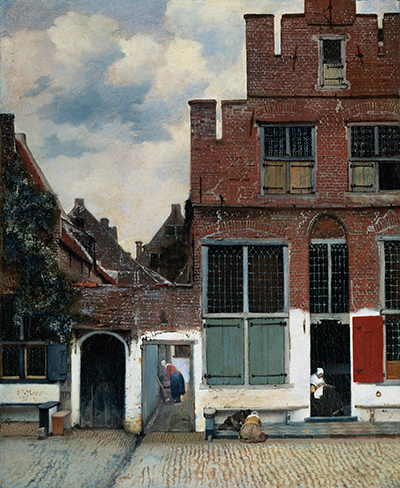The Little Street is an oil on canvas painting by meticulous artist Johannes Vermeer that dates back to 1658.
The gentle painting reveals a calm town during the Dutch Golden Age era with a cobble stone road and tall houses. The painting belongs to one of three paintings of the town Delft, with the other two titled View of Delft, and House Standing in Delft.
These paintings are the only artworks of Vermeer where the artist illustrated the natural environment around him.
The artist used an array of calm colours throughout the artwork to showcase the outside scenery. The painting materials Vermeer used to achieve the masterful application included red ochre and madder lake to achieve the red and brown colours throughout the painting, lead white and ultramarine to display the blues and white within the sky, and azurite to create a green colour.
These rare and expensive pigments at the time enabled the artist to display the rich colours and textures throughout the painting.
The location of the painting is based in 17th century Delft, where Johannes Vermeer lived and worked. The exact location of the painting remains in debated as art lovers continue to search for the place where the masterpiece was painted. Within the painting the viewer is able to witness a large building on the right that is three stories high covered in linear windows throughout.
Within the entrance of the large building is a woman seated on a stool in the doorway working on something within her hands. The building is made up of a rich red and brown coloured brick all the way to the top.
Near the top of the building, the viewer is able to witness how the surface of the building curves up in an unusual design. The architecture of the building gives historians a glimpse in the structures at the time, allowing theme to find where styles of architecture has evolved from.
To the bottom left of the building is another smaller building based on layers of brick built towards a triangular design. The remainder of the buildings within the background also continue the triangle styled architecture. The woman within the doorway of the building of the right is said to be Vermeer's Aunt who owned the store selling tripe. Vermeer's sister and mother were said to live on the opposite side of the building based on the painting.
As one of the only landscape paintings by Vermeer, the artist had decided to base the painting in a vertical form flattening out the surface.
The painting is based on the exact scene that met the artist's eye, painting directly what was in front of him. It is interesting to note the style in which the sky is painted as shades of light blue and grey mix into one another creating a light overcast. A green tree grows to the left of the painting is a deep teal colour against the brick building.
Vermeer's masterful technique enabled the artist to meticulously showcase the landscape of Delft, while still displaying the beautiful scenery around him.
The artist had not presented an array of outdoor paintings throughout his career, yet instead focused on portraits of woman in domestic settings. The artistry of Vermeer up rose recently as the art world witnessed his immense skill and attention to detail.




